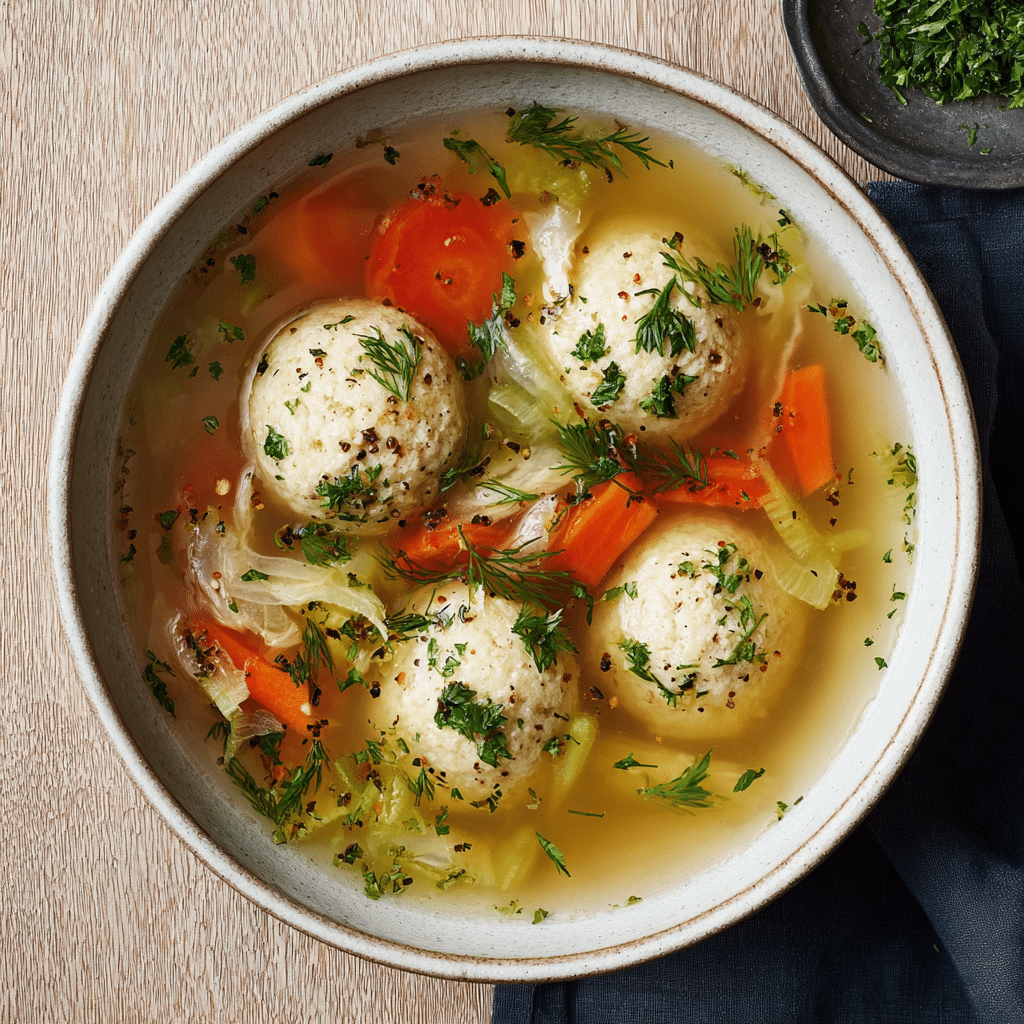For generations, this Classic Matzo‑Ball Soup has warmed tables and hearts alike. Made with fluffy, pillowy matzo balls that soak up rich, homemade chicken broth, and studded with tender carrots, celery, and onion, it’s the ultimate comfort dish. Whether you’re chasing away a chill or longing for a nostalgic taste of family traditions, this soup delivers warmth from bowl to soul.
What elevates this version is the use of schmaltz (or butter) in the batter and aromatic fresh parsley in both the matzo balls and garnish. The result? A golden-hued broth brimming with flavour and nourishing simplicity. Easy enough for a weeknight and elegant enough to serve guests, this soup is a timeless embrace in every spoonful.
Full Recipe
Ingredients:
-
6 cups homemade chicken broth (ideally simmered with aromatics)
-
2 large eggs
-
1 cup matzo meal
-
¼ cup schmaltz or melted butter
-
2 tablespoons finely chopped fresh parsley
-
½ teaspoon kosher salt
-
¼ teaspoon black pepper
-
3 large carrots, sliced on the diagonal
-
2 celery stalks, sliced
-
1 small onion, diced
-
Extra chopped parsley, for garnish
Directions:
-
Whisk eggs, schmaltz, parsley, salt, and pepper in a bowl. Stir in matzo meal until just combined. Cover and refrigerate for 30 minutes.
-
While dough chills, bring chicken broth to a gentle boil in a large pot.
-
Form chilled batter into walnut‑sized balls using wet hands (about 12–14).
-
Gently drop matzo balls into simmering broth, cover, and cook over low heat for 25–30 minutes until fluffy and cooked through.
-
Meanwhile, in a separate saucepan, sauté carrots, celery, and onion until tender, about 5–7 minutes.
-
Once vegetables are softened, add them to the broth with matzo balls. Heat through gently for 5 minutes.
-
Taste and adjust seasoning. Ladle soup into bowls, ensuring each has matzo balls, veggies, and a ladle of broth. Garnish with extra parsley.
Prep Time: 10 minutes | Cooking Time: 45 minutes | Total Time: 55 minutes | Kcal: 300 per serving | Servings: 4
The Rich Heritage Behind Matzo Ball Soup
Matzo Ball Soup is more than just a comforting bowl of broth and dumplings—it’s a cherished emblem of Jewish culinary tradition and heritage. This timeless dish traces its roots to Central and Eastern Europe, evolving through centuries of cultural and religious significance. Often served during Passover, but enjoyed year-round by many, matzo ball soup embodies the spirit of Jewish resilience, adaptability, and warmth.
The star of the dish, matzo meal, is derived from unleavened bread known as matzah, which is traditionally consumed during Passover in remembrance of the Exodus from Egypt. Matzo balls—also called kneidlach in Yiddish—are doughy dumplings made from matzo meal, eggs, fat (commonly schmaltz or oil), and seasoning. Simmered gently in chicken broth, these fluffy or dense dumplings (depending on personal preference and family tradition) absorb the savory flavors of the soup, turning each spoonful into a deeply nostalgic experience.
Why Matzo Ball Soup is the Ultimate Comfort Food
Comfort food often speaks a universal language, and Matzo Ball Soup is a perfect example. It hits every mark: it’s warm, savory, satisfying, and full of healing properties—especially if made with a well-crafted, homemade chicken broth. The addition of vegetables like carrots, celery, and onion enhances both the flavor and the nutritional profile of the dish.
Dubbed “Jewish penicillin” by many, Matzo Ball Soup is the go-to remedy for colds, fatigue, heartbreak, and homesickness. This association isn’t just sentiment—it’s supported by science. Chicken soup has been shown to have mild anti-inflammatory effects and helps clear nasal congestion. The soothing warmth of the broth, combined with the hearty texture of matzo balls, makes it a go-to meal for emotional nourishment as well.
The Role of Schmaltz in Flavor and Tradition
Traditionalists insist that the only way to make authentic matzo balls is with schmaltz—rendered chicken fat—which imparts a rich, savory depth to the dumplings. Schmaltz was once a staple in Jewish households, especially among Eastern European communities where butter or oil were less accessible or unsuitable for kosher meat meals. The use of schmaltz in the matzo ball mixture isn’t just about flavor—it’s a nod to the resourcefulness and ingenuity of past generations who made the most out of every part of the chicken.
Today, while schmaltz remains prized by purists, some cooks opt for more readily available fats like butter, margarine, or neutral oils. Each brings a slightly different flavor and texture, and experimenting with them allows cooks to tailor the soup to their own tastes or dietary needs.
Texture Matters: The Great Matzo Ball Debate
A key point of contention among matzo ball aficionados is whether the dumplings should be light and fluffy or dense and chewy. There’s no right or wrong answer—it largely depends on family tradition and personal preference.
Fluffier matzo balls tend to expand during cooking and float in the broth, absorbing more liquid and creating a soft, pillowy bite. These are achieved by not overmixing the batter and often by adding baking powder (although this is avoided during Passover by some who observe strict kosher rules). Denser matzo balls, on the other hand, are heavier and more filling, often described as “sinker” style.
No matter which you prefer, the secret lies in the dough’s rest time, the simmering method, and how gently the matzo balls are handled before cooking. Great care in the preparation transforms a simple set of ingredients into something deeply memorable.
Broth is the Soul of the Soup
While the matzo balls are the stars, the broth is what ties everything together. Traditionally, the broth is homemade from a whole chicken, bones, and a bouquet of aromatics simmered over several hours. The resulting liquid is golden, rich, and infused with deep umami flavor.
Some families include a piece of parsnip or dill for a brighter note, while others swear by garlic or peppercorns. The vegetables—carrots, celery, onion—are often left in the broth, adding texture and heartiness. Some cooks strain the broth for a crystal-clear finish, while others keep it rustic and full-bodied.
A shortcut using store-bought broth can certainly work in a pinch, but there is something truly special about a slow-simmered pot of homemade chicken stock. It’s not just about flavor—it’s about the care, time, and love poured into the dish.
Modern Variations and Adaptations
Matzo Ball Soup has evolved beyond its traditional framework in recent years. Creative cooks have started incorporating global flavors while still respecting the essence of the dish. Some twist the classic by infusing the broth with ginger, lemongrass, or turmeric for an Asian-inspired flair. Others experiment by adding greens like kale or Swiss chard, or by swapping chicken broth for a flavorful vegetable base to make it vegetarian.
Vegan and gluten-free versions are also becoming more common. Gluten-free matzo meal is now widely available, making this dish more inclusive for those with dietary restrictions. For a vegan version, vegetable oil replaces schmaltz, and the broth is built with roasted veggies and mushrooms for depth.
These modern renditions showcase the flexibility of matzo ball soup and its ability to adapt while still holding onto its identity.
Serving and Presentation Tips
Presentation can elevate matzo ball soup from humble to elegant. Serve in wide, shallow bowls so each matzo ball is showcased atop a shimmering surface of broth. A final sprinkling of fresh parsley or dill adds brightness and a pop of color. For a festive occasion, you can float thin carrot ribbons or julienned vegetables for added visual appeal.
For larger gatherings or holiday meals, consider serving the soup in a large tureen, allowing guests to ladle their own portions. Keep extra matzo balls warm on the side to replenish bowls throughout the meal.
This soup also stores well, making it a perfect make-ahead option. Store the matzo balls separately from the broth to maintain their texture when reheating.
Matzo Ball Soup and Jewish Identity
Beyond its flavor and comfort, matzo ball soup holds a special place in Jewish identity. It’s often the first dish learned from a parent or grandparent, the one made with care on holidays, or the one brought to a friend in need. Every family has their own version, and every cook adds their own touch—a pinch more dill, a dash less salt, the “right” fat, the “wrong” way to shape the balls, and endless stories behind them.
In this way, matzo ball soup is as much about memory and family as it is about food. It connects generations and provides a tangible link to ancestry and tradition. Whether it’s made once a year or once a week, this dish is a thread in the fabric of Jewish culinary life.
Conclusion: A Soup That Nourishes Body and Soul
Matzo Ball Soup is more than just a meal—it’s a warm embrace, a symbol of tradition, and a carrier of countless memories. Its simplicity belies its depth, both in flavor and cultural meaning. Whether you’re cooking it as part of a religious celebration, sharing it with someone who needs a little comfort, or simply craving something soothing and nourishing, this dish never disappoints.
In a time where food often serves as a bridge between generations and cultures, Matzo Ball Soup stands as a powerful reminder of the enduring strength of tradition, the comfort of home cooking, and the joy of sharing something meaningful with the people you love. From its humble ingredients to its heartfelt preparation, this beloved soup continues to bring warmth to tables—and souls—across the world.






